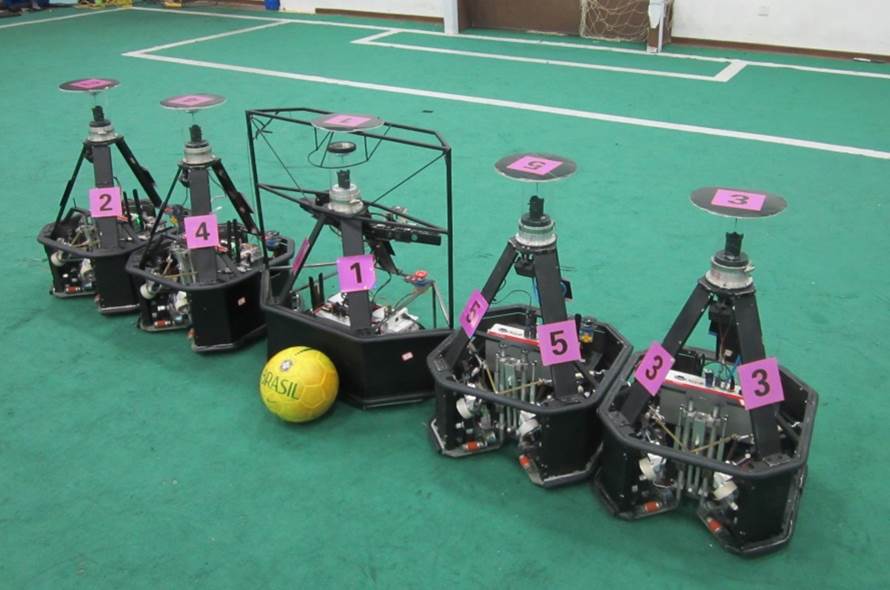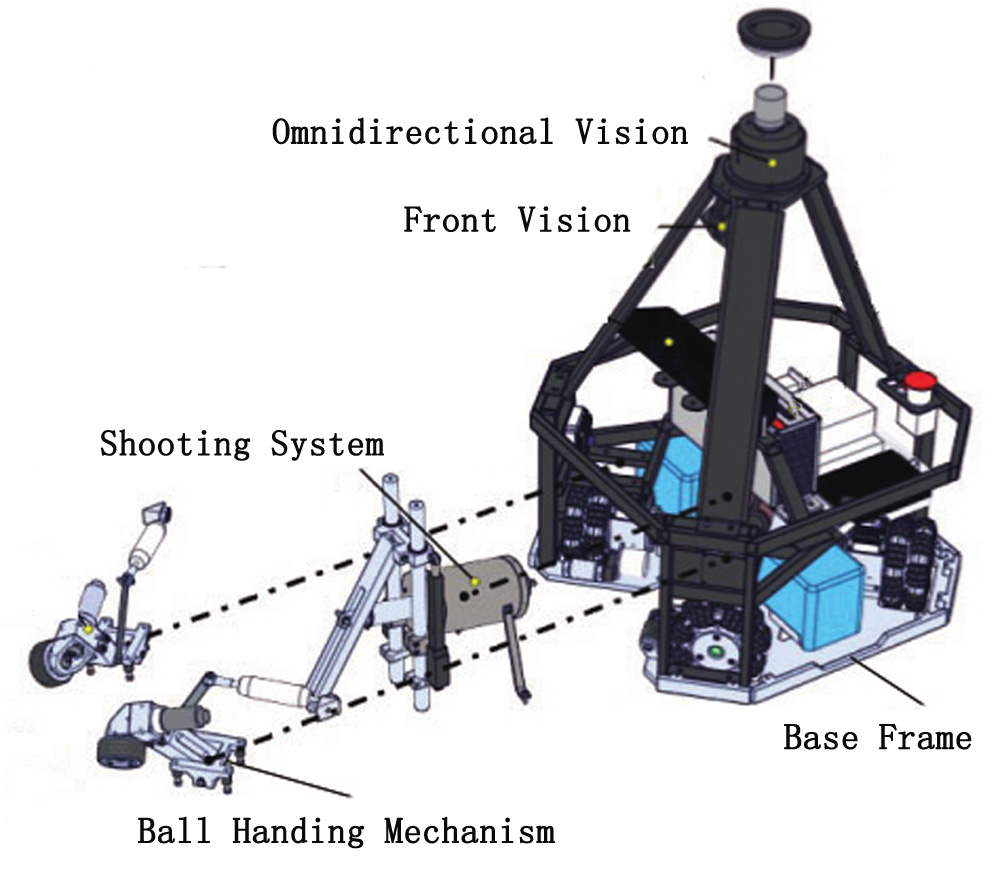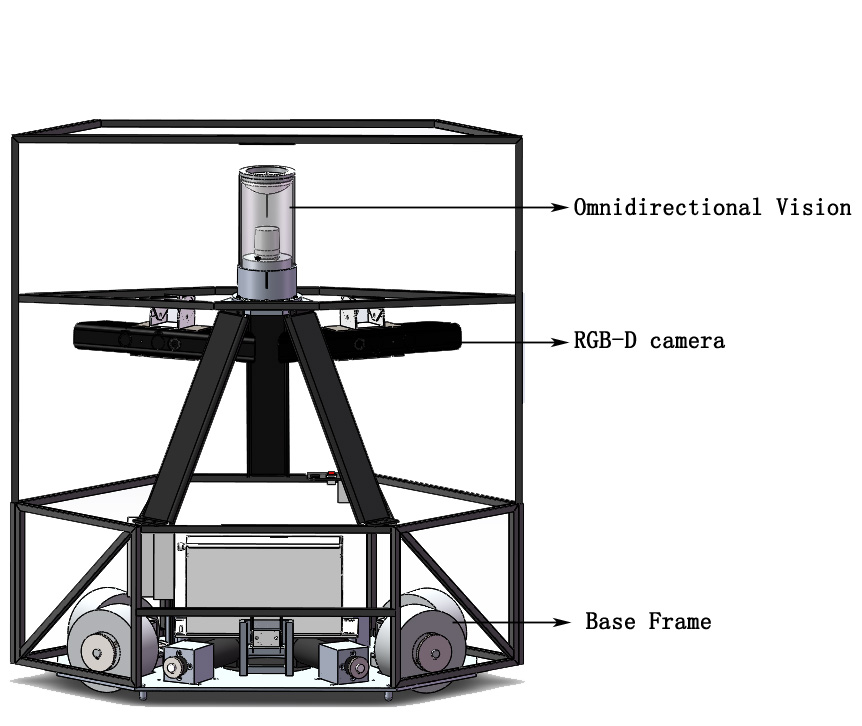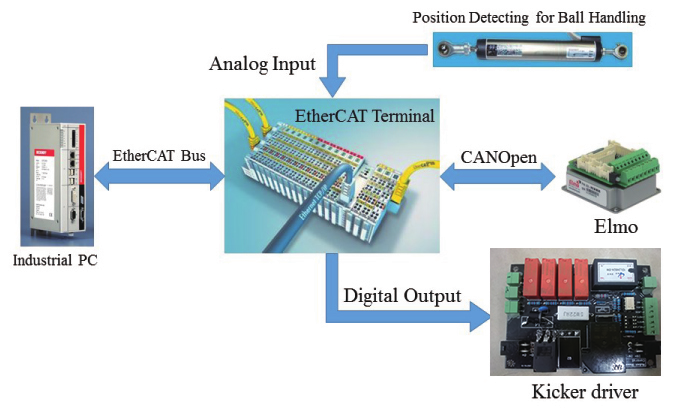Led by Prof. Zhiqiang Zheng, our NuBot team was founded in 2004. Currently we have two full professors (Prof. Zhiqiang Zheng and Prof. Hui Zhang), one associate professor (Prof. Huimin Lu), one assistant professor (Dr. Junhao Xiao), and several graduate students. Till now, 8 team members have obtained their doctoral degree with the research on RoboCup Middle Size League (MSL), and more than 20 have obtained their master degrees. For more detail of each member please see NuBoters.
As shown in the figure below, five generations of robots have been created since 2004. We participated in RoboCup Simulation and Small Size League (SSL) initially. Since 2006, we have been participating in RoboCup MSL actively, e.g., we have been to Bremen, Germany (2006), Atlanta, USA (2007), Suzhou, China (2008), Graz, Austria (2009), Singapore (2010), Eindhoven, Netherlands (2013), Joao Pessoa, Brazil (2014), Hefei, China (2015), Leipzig Germany (2016), Nagoya Japan(2017), Montréal Canada(2018) and Sydney Australia(2019) . We have also been participating in RoboCup China Open since it was launched in 2006.

The NuBot robots have been employed not only for RoboCup, but also for other research as an ideal test bed more than robot soccer. As a result, we have published more than 70 journal papers and conference papers. For more detail please see the publication list. Our current research mainly focuses on multi-robot coordination, robust robot vision and formation control.
The following items are our team description papers (TDPs) which illustrates our research progress over the past years.
Real-time Object Segmentation for Soccer Robots Based on Depth Images
Qiu Cheng, Shuijun Yu, Qinghua Yu and Junhao Xiao
Object detection and localization is a paramount important and challenging task in RoboCup MSL (Middle Size League). It has a strong constraint on real-time, as both the robot and obstacles (also robots) are moving quickly. In this paper, a real-time object segmentation approach is proposed, based on a RGB-D camera in which only the range information has been used. The method has four main steps, e.g., point cloud filtering, background points removing, clustering and object localization. Experimental results show that the proposed algorithm can effectively detect and segment objects in 3D space in real-time.
The video can be found here if the below link does not work.
Many thanks to Dr. Gang Yin! The trustie platform is a well organized place for homing courses, groups, projects, and many more.

The NuBot MSL robots.
2016.01.15: 机器人基于云的目标识别架构
报告人:程球1. 文章:A Cloud-based Object Recognition Engine for Robotics的一些分享
主要介绍一种基于云的目标识别框架(CORE)进行云计算来处理目标识别任务,CORE是分布式,模块化和可扩展的软件体系,它在机器人网络中能够有效地执行数据的传输和处理。
2.全向视觉系统标定中遇到的一些问题以及解决方法。
1. 论文 An Onboard Monocular Vision System for Autonomous Takeoff, Hovering and Landing of a Micro Aerial Vehicle 中无人机姿态估算方法及其局限性;
2. 基于PTAM与PnP算法对其局限性的改进。
大规模开放在线研究(Massive Open Online Research,MOORE)是我校杨学军院士提出的面向高校的新型创新实践概念,为全面支持高校科学研究和人才培养提供了新思路。
在研究生院MOORE教学环境项目支持下,机器人技术创新基地现面向全校研究生不定期发布一批创新课题,欢迎对机器人足球和自主移动机器人技术感兴趣的硕士和博士研究生申请课题,针对每个创新课题会有实验设备支持和必要的经费支持。NuBot有自主研制的基于ROS和Gazebo的三维仿真系统,用于支持算法研究和验证,尤其是多机器人协同控制和基于通信的全分布式控制算法。算法在仿真环境验证后可以到机器人创新基地实际机器人系统上测试,真正做到线上线下协同创新。
此外,我们非常欢迎硕士研究生来机器人技术创新基地选题,完成硕士毕业设计论文,让我们一起和机器人足球成长进步。
如有兴趣,请联系卢惠民博士(lhmnew_at_163.com)和肖军浩博士(junhao.xiao_at_hotmail.com),电话:0731-84576455。
当然可以!只要对机器人技术创新基地中型组足球机器人的发展做出了贡献,我们将邀您一起征战机器人足球世界杯!2016年德国,2017年俄罗斯,2018年日本,欢迎加入我们战队!
在机器人比赛中,目标的检测和识别是移动自主机器人的基础问题之一,尤其是带有视觉感知且能与现实世界相互交互的移动机器人。目标识别对机器人来说是非常重要的一个环节,也是机器人实现协同协作、运动规划、控制决策等自主能力的前提,是自主移动机器人领域的热点问题。移动机器人在真实环境中的目标识别有一些基本因素:目标的多样性(纹理,无纹理和平面等),低精度传感器的图像噪声,视角的差异性和阴影等。
本课题主要是研究基于RGB-D的目标检测和目标识别方法。基于视觉的识别过程中,怎样提取RGB-D图像中的3D特征是一个比较重要也是非常困难的问题。目标检测实际上主要是关键点检测,特征提取,特征分类,感兴趣区域的生成和目标定位等一系列环节完成的。移动机器人通过3D传感器获取包含颜色和深度信息的点云,可以分别通过形状特征、视觉特征和融合形状和视觉特征的方法对物体进行目标识别。然而,大部分的目标识别的算法计算量比较大,基于RGB-D的目标识别算法实时性一般达不到实际的应用要求。研究基于RGB-D的自主机器人实时识别算法对提高机器人在比赛环境中实时辨别障碍、环境感知能力等具有重要意义。
针对中型组足球机器人比赛环境,对低成本RGB-D摄像头获取的3D点云进行点云分割、特征提取,并根据提取的特征和特征描述算子实现目标的检测和识别,要求设计的算法必须满足实时性和鲁棒性,且识别率不低于90%。
NuBot机器人平台
微软Kinect相机
实验场地
NuBot机器人仿真软件
NuBot机器人软件系统
The Mechanical system of our whole MSL robot is subdivided into five main modules: the base frame, the ball handling mechanism, the electromagnet shooting system, the omnidirectional vision system and the front vision system, as illustrated in Fig.1a For the goalie robot, the ball handling mechanism, the electromagnet shooting device and the front vision system are removed, instead two RGB-D cameras are integrated as shown in Fig.1b.Each modules has its specific function.The base frame is a 4-wheel-configuration platform which can move in all direction and generate more traction force than a normal 3-wheel-configuration one.The each side of the ball handing mechanism contains a wheel, a DC motor, a set of transmission bevel-gear, a linear displacement transducer and a support mechanism. It enables the robot to catch and dribble a ball during the game.The electromagnet shooting system can be subdivided into three categories: spring mechanisms, pneumatic systems and solenoids.It enables the robot to pass the ball and shoot. The omnidirectional vision system which is composed of a convex mirror and a camera pointing upward towards the mirror not only makes the imaging resolution of the objects near the robot on the field constant and the imaging distortion of the objects far from the robot small in the vertical direction, but also enables the robot to acquire a very clear image of the scene which is very close to it, such as the robot itself. The front vision system and the RGB-D camera are auxiliary sensors for the regular robots and the goalie robot, respectively.

Fig.1a The NuBot regular robot

Fig.1b The goalie robot
Our current electrical system uses PC-based control technology as shown in Fig 2,so that all vision and control algorithms are processed on the industrial PC. The industrial PC communicates with the EtherCAT system via Ethernet. In addition,the system also uses Elmo Motion Control (SOL-WHI 20/60) which is the intelligent miniature digital servo drive for the 150W DC brushless motor, the CANopen modular EL751 embedded in the EtherCAT which is used to realize communication between the industrial PC and the Elmo Motion Controls, the kicker driver,also named as shooting module, which is mainly composed of a relay and an IGBT FGA25N120ANTD. The PC can send control signals to the kicker driver for shooting or passing via the EtherCAT. The system can meet the demands of the RoboCup MSL competition and provide a good solution for the design of an intelligent robot.

Fig.2 The NuBot electrical system
Our software is developed on Ubuntu, and it is also open source.Therefore, we also use ROS to build our NuBot software. The operating system is Ubuntu 14.04, and the version of ROS is Indigo. As shown in Fig.3, the software framework is divided into 5 main parts: the Prosilica Camera node and the OmniVision node; the UVC Camera node, the FrontVision node and the Kinect node; the NuBot Control node; the NuBot HWControl node; the RTDB and the WorldModel node. Two Kinect nodes replace the FrontVision node and the UVC Camera node for the goalie.

Fig.3 The software framework based on ROS
The team description paper can be downloaded at here, with the main contribution of a Gazebo based simulation system compared to our 2015 TDP.
[1] Xiong, D.,Xiao, J., Lu, H., Zeng, Z., Yu, Q., Huang, K., ... & Zheng, Z. (2015). The design of an intelligent soccer-playing robot. Industrial Robot: An International Journal, 43(1). [PDF]
[2] Yao, W., Dai, W., Xiao, J., Lu, H., & Zheng, Z. (2015). A Simulation System Based on ROS and Gazebo for RoboCup Middle Size League, IEEE Conference on Robotics and Biomimetics, Zhuhai, China. [PDF]
[3] Lu, H., Yu, Q., Xiong, D., Xiao, J., & Zheng, Z. (2015). Object Motion Estimation Based on Hybrid Vision for Soccer Robots in 3D Space. In RoboCup 2014: Robot World Cup XVIII (pp. 454-465). Springer International Publishing. [PDF]
[4] Lu, H., Li, X., Zhang, H., Hu, M., & Zheng, Z. (2013). Robust and real-time self-localization based on omnidirectional vision for soccer robots. Advanced Robotics, 27(10), 799-811. [PDF]
[5] Lu, H., Yang, S., Zhang, H., & Zheng, Z. (2011). A robust omnidirectional vision sensor for soccer robots. Mechatronics, 21(2), 373-389. [PDF]
2rd place in MSL technique challenge in RoboCup 2015, Hefei, China
3rd place in MSL scientific challenge in RoboCup 2015, Hefei, China
6th place in in the MSL of RoboCup 2015, Hefei, China
5th place in RoboCup 2014 João Pessoa Brazil, July 19th~25th
3rd place in MSL of 9th RoboCup China Open, October 10th~12th, Hefei, China
3rd place in both MSL technique challenge of RoboCup ChinaOpen, October 10th~12th, Hefei, China
Entering into the top 8 teams in the MSL of RoboCup 2013 Eindhoven
Champion in the MSL technical challenge 1 of 8th RoboCup China Open, Dec 18th~20th, HeFei, China
The qualification video for RoboCup 2016 Leipzeig, Germany should be shown below. If it does not appear, it can be found at our youku channel (recommended for users in China) or our youtube channel (recommended for users out of China).
NuBot Team Mechanical and Electrical Description together with a Software Flow Chart can be downloaded here.
Junhao Xiao, one member of NuBot team, he is served to MSL community as a member of TC of RoboCup 2016 Leipeig, Germany; and has served to MSL community as a member of TC and OC of RoboCup 2015 Hefei, China, and he has also been appointed as the local chair of RoboCup 2015 MSL.
Huimin Lu, one member of NuBot team, served to MSL community as member of TC and OC of RoboCup 2008 Suzhou , and He was also appointed as the local chair of RoboCup 2008 MSL. He was a member of TC of RoboCup 2011 Istanbul.